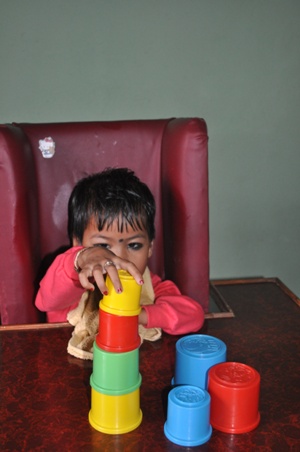 PRANJAL POUDEL |
Seven-year-old Rhydm is one of estimated 80,000 people in Nepal who have cerebral palsy. His mother Tulasa Khadka, and another parent, Bimala Sigdel decided that while helping their own children they should help as many other Nepali children with the same affliction.
So, they set up the Cerebral Palsy Centre in Gatthaghar outside Kathmandu, and there are now eight children including their own who receive physiotherapy and other care.
The Centre has received help from Self-help Group for Cerebral Palsy (SGCP) the only one of its kind addressing the needs of children with this condition, which impairs the body's motor functions due to a brain disorder.
What started out in a rented house in 1987 is now a well-developed centre where children with the affliction are rehabilitated.
 PRANJAL POUDEL |
But SGCP's Bimal Shrestha admits that it is still difficult to convince schools to take children with cerebral palsy, mainly because of objection from other parents.
"Such is the stigma that mothers lock up their cerebral palsy children in the attics and in cages," says Shrestha.
The centre is chronically short of funds, and has to struggle against official and public apathy. "Normally," Sigdel says, "parents refuse to invest in children with cerebral palsy because they think there is no return on the investment." Many parents are poor, and just can't bear the added burden, she adds.
"People don't want to devote a lot of time to children who have cerebral palsy and it is very hard to convince them to," explains Shrestha, "it is usually the mother who has to take care of the child and often she has to bear ridicule from in-laws and even husbands for bringing bad luck."
There are also very few medial professionals trained in taking care of children with cerebral palsy, and even fewer hospitals and shelters that specialise in their care.
Most children with mild or moderate or even severe cerebral palsy can go on to be well educated with the famous example of the writer Jhamak Ghimire who this month won Nepal's most prestigious literary award, Madan Puraskar.
Even at SGCP, a student has gone on to give her SLC examination. But if the condition is coupled with epilepsy or mental illness, the child may be severely limited.
 PRANJAL POUDEL |
Back at the centre, Khadka's son is clapping his hands happily. It is a drop in the ocean because thousands of other children like him throughout Nepal are not so lucky.
Stuti Sharma
To help the SGCP, call 5573699, 9851042469
To help the Gatthaghar Cerebral Palsy Centre, contact Tulasa Khadka at 9841736596
Read also:
Different, but able, BHRIKUTI RAI
Bungmati school lets children overcome disability by working on their abilities


